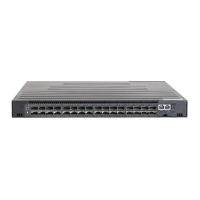C
HAPTER
14
| Basic Administration Protocols
Ethernet Ring Protection Switching
– 493 –
Show
◆ Domain Name – Name of a configured ERPS ring.
◆ ID – ERPS ring identifier used in R-APS messages.
◆ Admin Status – Shows whether ERPS is enabled on the switch.
◆ Ver – Shows the ERPS version.
◆ MEG Level – The maintenance entity group (MEG) level providing a
communication channel for ring automatic protection switching (R-APS)
information.
◆ Control VLAN – Shows the Control VLAN ID.
◆ Node State – Shows the following ERPS states:
■
Init – The ERPS ring has started but has not yet determined the
status of the ring.
■
Idle – If all nodes in a ring are in this state, it means that all the
links in the ring are up. This state will switch to protection state if a
link failure occurs.
■
Protection – If a node in this state, it means that a link failure has
occurred. This state will switch to idle state if all the failed links
recover.
◆ Type – Shows node type as None, RPL Owner or RPL Neighbor.
◆ Revertive – Shows if revertive or non-revertive recovery is selected.
◆ W/E – Shows information on the west and east ring port for this node.
◆ West Port – Shows the west ring port for this node.
◆ East Port – Shows the east ring port for this node.
◆ Interface – The port or trunk which is configured as a ring port.
◆ Port State – The operational state:
■
Blocking – The transmission and reception of traffic is blocked and
the forwarding of R-APS messages is blocked, but the transmission
of locally generated R-APS messages is allowed and the reception of
all R-APS messages is allowed.
■
Forwarding – The transmission and reception of traffic is allowed;
transmission, reception and forwarding of R-APS messages is
allowed.
■
Unknown – The interface is not in a known state (includes the
domain being disabled).
◆ Local SF – A signal fault generated on a link to the local node.

